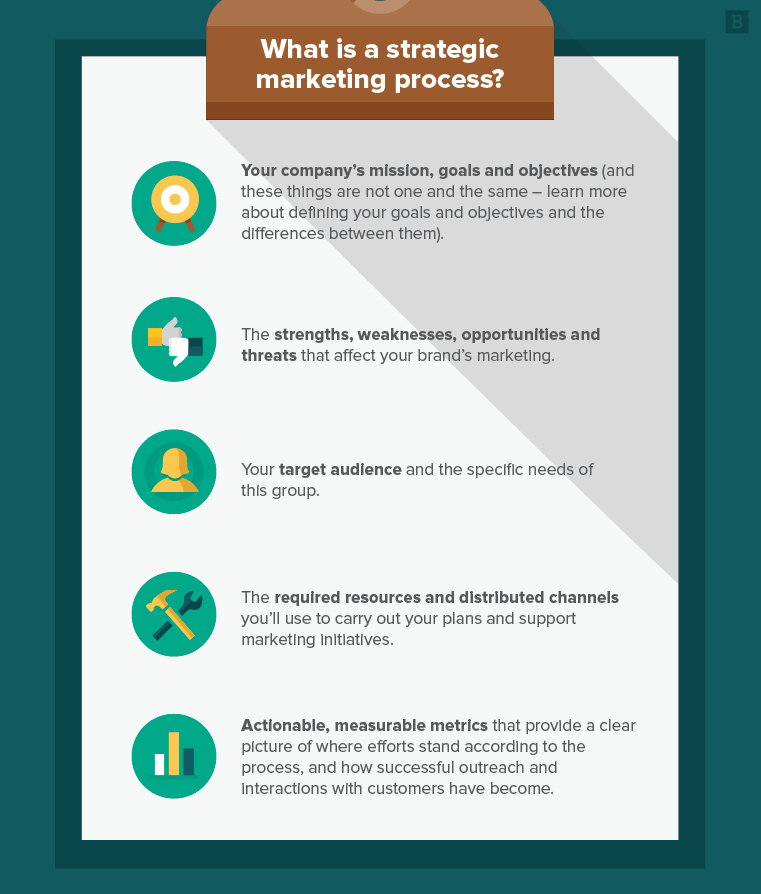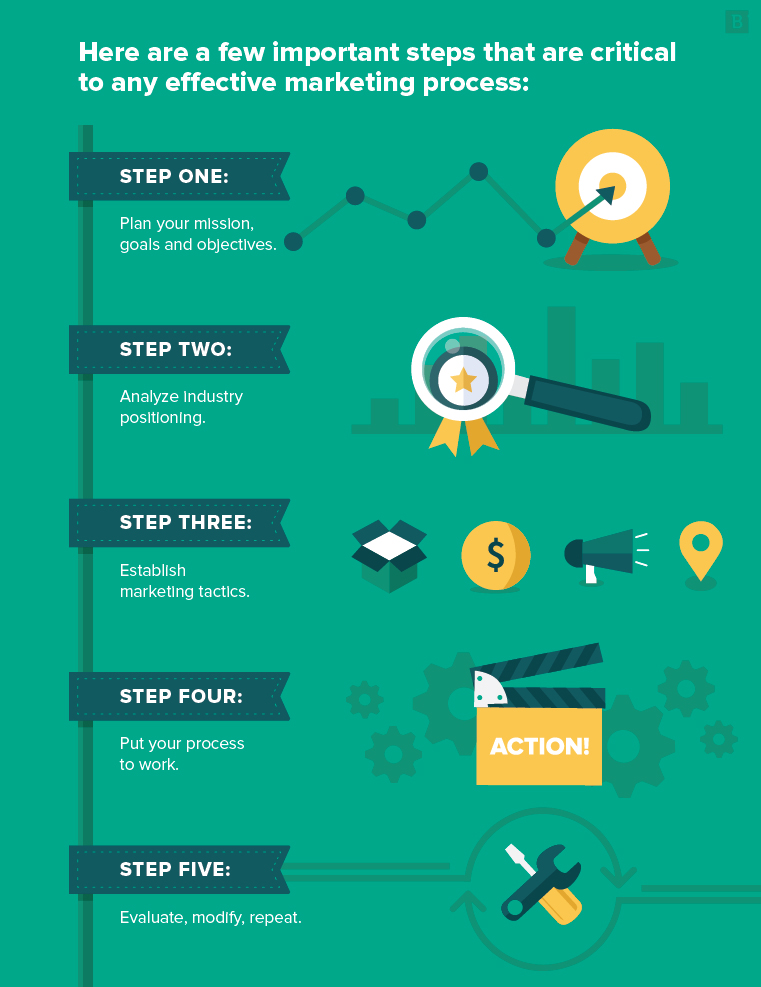A strategic marketing process is a framework by which brands identify a target audience, capitalize on competitive differentiators, create content and disseminate their message to the market. The process is an end-to-end operating model for achieving marketing goals and business objectives.
Strategic Marketing Planning in 5 Steps: Watch the Video
The strategic marketing planning process gives marketers the opportunity to evaluate their industry positioning and that of their competitors. It also helps the whole marketing team identify tactics that can help them reach their target audience, expand brand awareness, create customer satisfaction and achieve other business goals.
Here are the 5 steps to get you started:

1. Plan Your Mission, Goals and Objectives
Before doing anything else, your marketing leaders and stakeholders must sit down and define your business’s mission, including the goals and objectives that will propel your strategic marketing.
If your company already has an established mission statement, congrats! You’re ahead of the game.
A mission statement should explain why your organization exists, why it does business and how it supports and benefits its customers. Some mission statements are aspirational and motivating; some are more formal in their approach. Just ensure your mission statement matches the intent and culture of your company.
Next, you should map out the goals and objectives that will drive every effective marketing effort. Remember, be SMART about it. That is to say, your goals should be:
- Specific.
- Measurable.
- Aspirational.
- Realistic.
- Time-bound.
The digital marketing landscape changes daily, so you should expect your tactics to evolve regularly. But your underlying goals and core mission should be more evergreen. Marketing processes need to be rigid enough to work well over time but flexible enough to adapt to quick pivots as needed.
2. Analyze Industry Positioning
With your mission statement, goals and objectives mapped out, it’s time to turn an eye outward. See where your company lies in terms of the overall industry and how it’s positioned in current customer relationships.
This step includes two essential strategies: SWOT analysis and positioning research.
SWOT stands for:
- Strengths, or the things your company does well in comparison to its competitors.
- Weaknesses, or the factors that may hold your organization back from market success.
- Opportunities, including external elements like trends that could create the potential for new business or revenue streams.
- Threats, or external factors (economical, political, technological, etc.) that might create obstacles for your company.
Where SWOT focuses on internal factors and external market elements, positioning seeks to better define the ways in which the brand is perceived in comparison to its competitors through the lens of the customer.
As Brafton’s own Dominick Sorrentino explained, brand positioning focuses on creating a compelling brand identity that establishes a memorable impression for customers in your target demographics.
A high-end car dealership that wants to position itself as a seller of luxury vehicles, for example, will look to use certain words and imagery in its marketing to craft a specific value proposition for its target audience.
It’s important to consider how your current and potential customers perceive your company and if there are any changes you should make to create your ideal brand image. Where you fit in the marketplace should influence tactical decisions, from why a certain keyword is included in your inbound marketing strategy to which buyer personas you intend to target.
3. Establish Marketing Tactics
During this stage, consider your marketing mix, based on the 4 Ps of marketing from E. J. McCarthy. While these were first created back in 1960, they’re still very relevant today. They include:
- Product: The items or services your brand offers in response to customer wants and needs.
- Price: The cost of the product and the value provided to the customer.
- Promotion: The marketing efforts you use to support the product, including messaging specific to your target market.
- Place: The physical and digital distribution channels you use to enable sales.
The right mix will depend on your market segments.
Through the prism of your marketing mix, you can more clearly define how your content strategy will map to your overall marketing strategy. In other words, you can set baselines for:
- How much more market research you need to do.
- The type of marketing assets needed and how many.
- The marketing campaigns that take priority.
- The marketing opportunities to exploit and on what timeline.
- The investment required to execute successful inbound or outbound marketing programs.
This is the time when your marketing processes are codified and resources are put into place for a full-scale campaign launch.
Subscribe to
The Content Marketer
Get weekly insights, advice and opinions about all things digital marketing.
Thank you for subscribing to The Content Marketer!
4. Put Your Process To Work
This step entails execution.
With your marketing mix defined, investments supplied and plans agreed upon, the content creation process is now in motion. In addition to creating content, you’ll also need to collect and validate all the data pertaining to your marketing activities, including:
- Channel performance metrics.
- Marketing- or sales-qualified leads (MQLs and SQLs).
- Brand reach.
5. Evaluate, Modify, Repeat
This phase is where many organizations misstep. It’s important to keep in mind that your strategic marketing process will be an ongoing effort — you should continually look for places to improve and enhance the plan.
Once you’ve executed your marketing strategies and tactics, it’s time to take a look back at your defined goals and objectives, and the metrics you created along with those according to your SMART planning. These will be crucial in helping you gauge the overall success of your efforts according to your mission statement and goals.
Mine Google Analytics and all data from your marketing automation platforms, then compile everything into a report for greater analysis. Most tools provide real-time data, so you can check in daily to measure your marketing progress. (Tip: Look into artificial intelligence tools, too!)
Monthly or quarterly, do a more in-depth audit and investigation of your marketing performance down to the last dollar. Is total return on investment anywhere in sight? Are certain types of content underperforming? Is your audience engaging and is this leading to any measurable increase in customer satisfaction?
At periodic intervals, adapt your marketing processes to keep your company accountable and effective.

Get Ahead of Marketing Program Issues
There are quite a few moving parts involved with any strategic marketing plan, and it’s often a somewhat complex and involved process that will include a variety of company stakeholders.
To avoid undue confusion or waning investment in your marketing plan, avoid these common issues:
- Assumptions without data: Don’t assume anything without tangible data insights. Marketing can too often become subjective or based on a hunch. Validate all of your strategy decisions with customer and marketing research to remain effective.
- Opaque strategy: Those spearheading the creation of the strategic marketing process should be sure that all components are free of ambiguity. This goes for timelines, benchmarks, goals, tactics — everything.
- Lack of resources: Realizing you don’t have the resources to execute — due to turnover, underfunding, etc. — can derail a marketing plan immediately. While you want to go big, be realistic. Don’t set goals that are too lofty, only to be left pointing fingers when things go off the rails. Define whether internal or external resources are required for each step and carefully juggle your content marketing management efforts.
Process drives your marketing’s success or failure — so plan accordingly.

Editor’s note: Updated May 2023.





